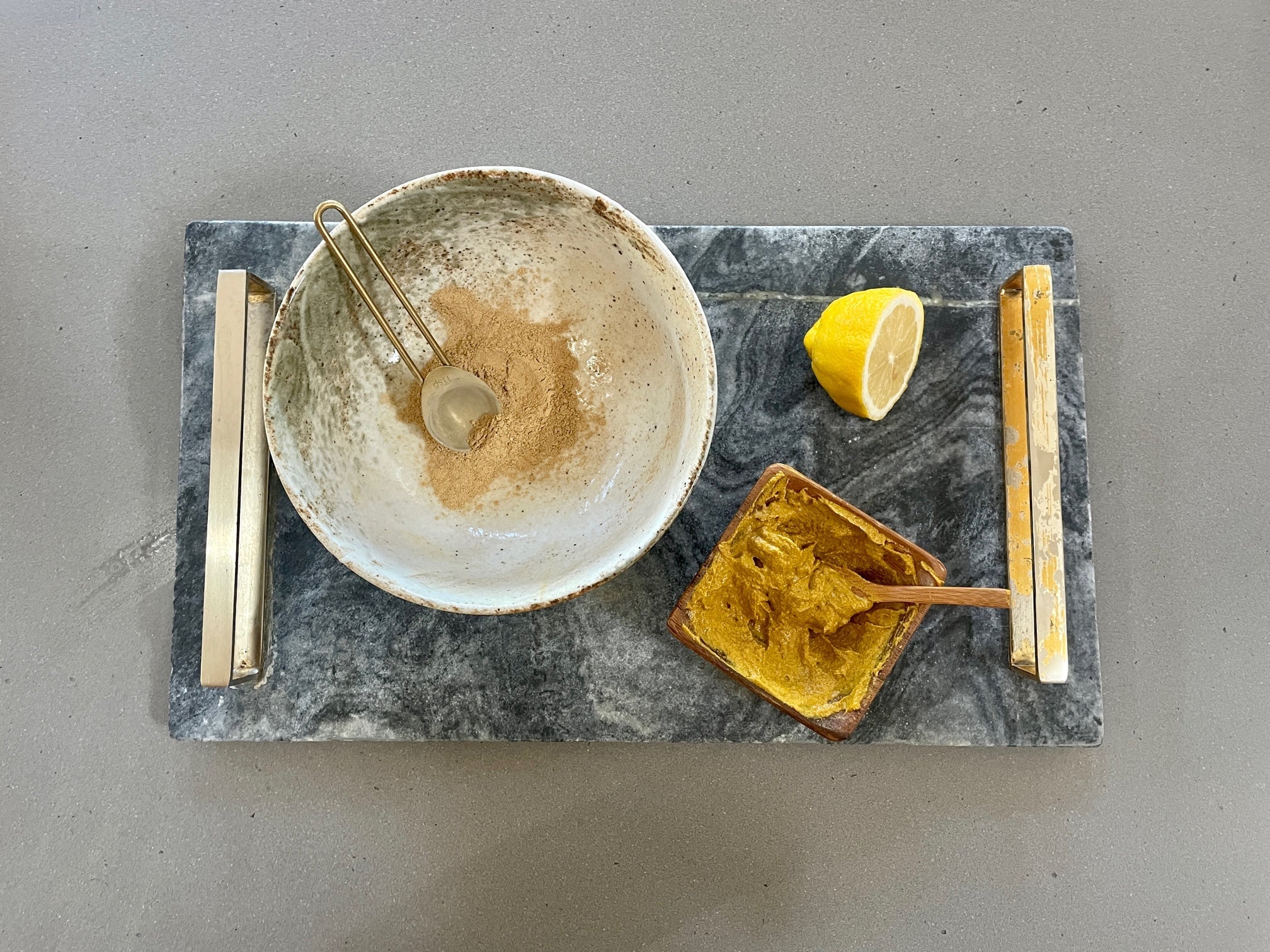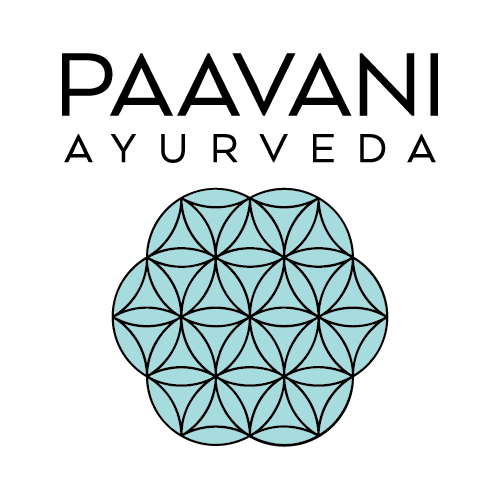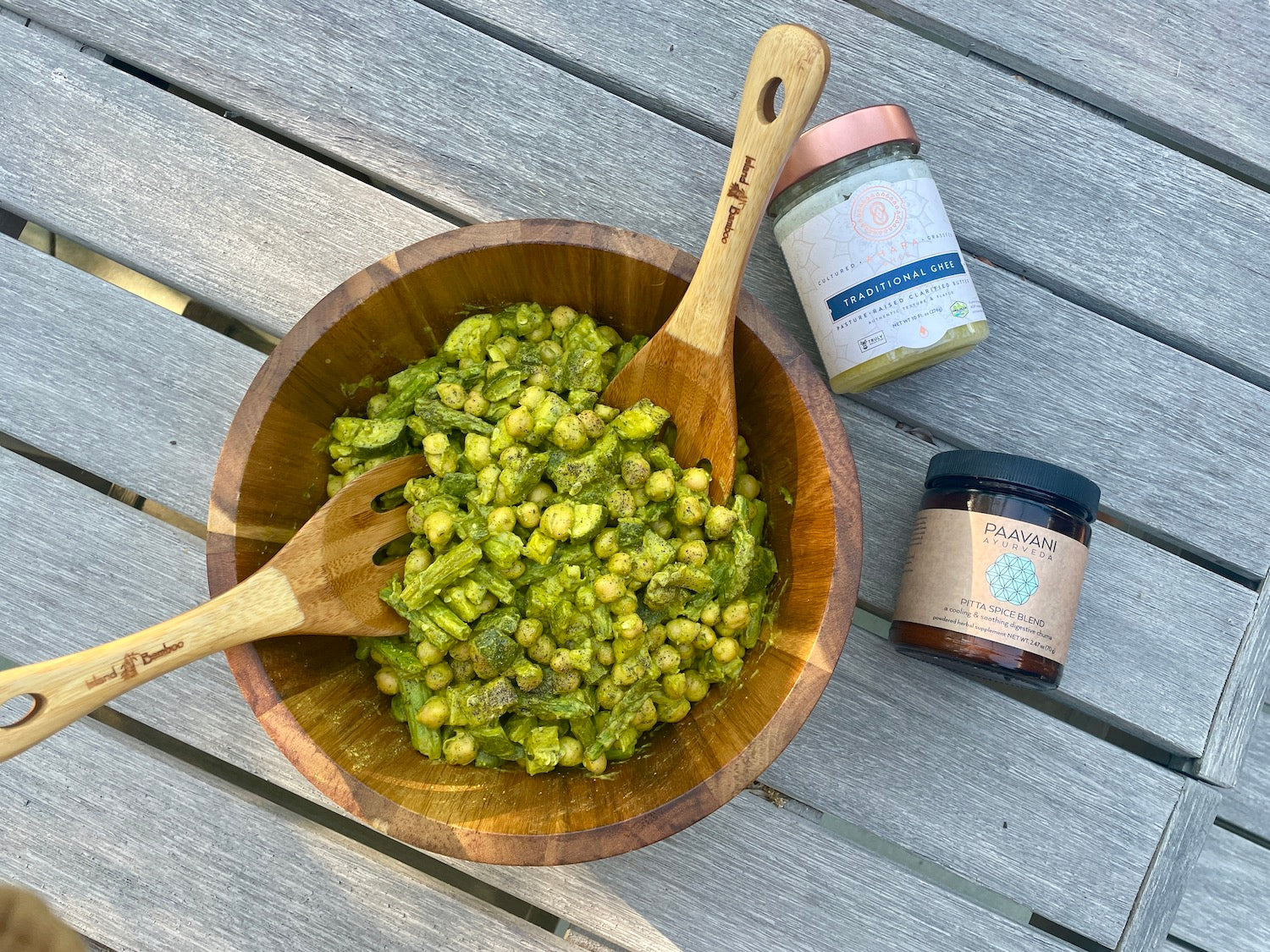
The Ayurvedic Approach to Hyperpigmentation
We have all heard at least one, if not all, of the terms: brown spots, dark spots, sun spots, liver spots, age spots, uneven skin tone and dark patches, which all point to one culprit, hyperpigmentation. Hyperpigmentation of the skin occurs when there is excess production of melanin, a substance in your body that gives your skin pigment or color. When in excess, melanin can cause dark spots on the skin’s surface, hence the name “hyper” (excessive) “pigmentation” (coloring). To be even more precise, an enzyme contained within melanin called tyrosinase is the main contributor to discoloration and the true arch-enemy of those battling an uneven skin tone. Hyperpigmentation can come in small or large patches on any part of the body; however, it is most common on the face and hands.

Common Causes of Hyperpigmentation:
Sun Exposure
Chronic exposure to ultraviolet (UV) light from the sun is the number one cause of hyperpigmentation. This sun damage is because UV rays trigger the production of melanin, and over time, as we age, the melanin accumulates in certain areas of the skin, causing small, flat dark spots. These spots are typically on the face, shoulders, hands and arms. This type of hyperpigmentation is also referred to as liver spots, age spots or solar lentiginosis.

Melasma
Melasma is a skin condition that causes more prominent dark spots that usually occur on the face as symmetrical patches commonly found on the forehead, cheeks, chin and upper lip. Excess UV rays can cause or trigger melasma, although hormonal changes are usually the root cause. Hence, the reason why melasma is common during pregnancy (referred to as “the face of pregnancy”, and 90% of people who develop melasma are women.
Post-inflammatory Hyperpigmentation
When a person is healing from acne, a wound and/or trauma to the skin, the body has a natural inflammatory response. When this inflammation occurs, it can cause excess melanin production, resulting in post-inflammatory hyperpigmentation (PIH). PIH appears as flat discoloration on the skin and is typically tan, brown or dark brown. When one has an acne scar, this is generally a result of PIH.
Blue Light Exposure
Screen time on your computer, laptop, tablet or smartphone could also contribute to an uneven skin tone and hyperpigmentation. New studies report that blue light emitted from our devices can negatively affect people with darker skin tones.

Genetics
It has been well documented that hyperpigmentation is more frequent and severe for people with darkly pigmented skin who don’t use proper sun protection. This sensitivity is common in individuals with Fitzpatrick III - VI skin types, including darker white, light brown, brown, dark brown and black skin. Interestingly, people with these skin types are usually less likely to burn from the sun; hence they may be the ones who are less likely to utilize SPF.
Ayurvedic Wisdom for Hyperpigmentation
If you are looking for an all-natural approach to reducing and/or treating pesky hyperpigmentation, we encourage you to explore what Ayurvedic medicine says about this subject. As always, Ayurveda’s holistic approach empowers us to reclaim our connection with nature’s circadian rhythm by slowing down and engaging in daily self-care to keep our skin, body and mind feeling its best.
Hydrate
Ayurveda shares that when we keep our bodies hydrated, toxins are flushed away and blood circulation to the skin increases. Through these actions, our skin cells can stay hydrated and refreshed, allowing them to resist the sun’s UV rays more readily. In short, proper hydration supports radiant, glowing skin and an even skin tone.
How much water will keep you hydrated each day? Ayurveda teaches that one should drink half their body’s weight in ounces of water daily. For example, if someone is 140lbs, they should drink at least 70 ounces of water each day and even more if they are engaging in strenuous exercise that results in perspiration.
Organic, Prana Rich Foods
Eating the colors of the rainbow, especially skinfood favorites like avocados, fatty fish, sweet potatoes, carrots, walnuts, sunflower seeds, watermelon, mangos, papaya and citrus fruits, are all wonderful ways to keep the skin looking and feeling its best. This is thanks to the antioxidant-rich properties that whole, prana (life force energy) rich foods dispense with their essential vitamins, minerals and healthy fats.
To discover healthy, balancing foods for your dosha, explore our vata, pitta and kapha blogs dedicated to this topic.
Break a Sweat
Treatments that make you perspire or sweat in Ayurveda are called svedana therapies. When we sweat, toxins that have built up in the body's organs are released, circulation increases and, yes, even our skin also benefits! Through svedana, clogged pores expel dirt, grime and toxins from our daily environment, which helps to decongest the skin. Additionally, through svedana, moisture is brought to the surface, rehydrating the skin. Also, the minerals and salt contained within sweat naturally exfoliate and brighten the skin’s surface.
What is the best way for you to break a sweat? Ayurveda suggests steam rooms and stabilizing, slow-moving, strengthening yoga for vata dosha. If you are predominant in pitta dosha, steam rooms for a short period of time are recommended, as well as stabilizing, slow-moving yoga enjoyed in the early morning hours when it is still cool and mild outside. For kapha dosha, Ayurveda recommends utilizing dry saunas and any form of cardiovascular exercises like power yoga, vinyasa yoga or jogging. Last but not least, all doshas can enjoy traditional svedana therapy, which involves an herbal steam tent or box to help induce sweating. The amount of time a person stays in the svedana therapy depends on the person’s Ayurvedic constitution and current state of the doshas.
Proper Sleep
Getting one’s beauty sleep is no joke! While asleep, your body repairs itself from the previous day’s stress, allowing time for your body to recharge and reset while you are at rest. Even more, if you incorporate the PAAVANI Skincare Ritual into your evening routine, your skin can optimally restore and absorb all of the healing antioxidants and nourishing properties of each product.
A good night’s sleep varies between 6-9 hours per night. Your predominant constitutional dosha determines how much sleep is necessary to feel fully rested and rejuvenated. For instance, a kapha type thrives on 6 or 7 hours of sleep, while a vata type does best with 8-9 hours and a pitta type performs optimally with 7-8 hours per night.
To go to bed at the same time each night and rise at the same time each morning is the best way to ensure a proper night’s sleep. According to Ayurveda, one should be in bed no later than 10 pm and awake no later than 6 am. This timing honors the cycle of the doshas and will guarantee the deepest, most productive “beauty sleep.”
Invest in Blue Light Protection
Blue light screen protectors and glasses, like the ones offered by Ocushield, will block the amount of blue light exposure throughout your day. According to Ocushield, their screen protectors block 90% of blue light between wavelengths 380 nm to 420 nm and up to 40% blue light from 420 to 500 nm. Ocushield glasses and clip-on lenses block 95% of blue light between wavelengths 380 nm to 420 nm and up to 50% from 420 to 500 nm. Hence, b lue light blockers provide a significant amount of protection that will reduce the adverse effects of blue light.
SPF Protection
Applying skin protection daily onto the face as a lightweight mineral sunscreen will help reduce melanin production and subdue further skin hyperpigmentation. We recommend sunscreen with SPF 50 as it protects you from about 98% of UVB rays. Our goto tinted mineral sunscreen is Sunforgettable Total Protection Face Shield Flex SPF 50 by Colorscience. This hydrating, antioxidant-rich all-mineral formula is powered by patented EnviroScreen® Technology which means comprehensive defense against UVA/UVB, blue light, pollution and infrared radiation, combined with advanced antioxidants and nourishing, hydrating ingredients for long-term skin health.
Exfoliate the Skin Daily
Ayurvedic skin care recommends gently exfoliating the skin daily to clear dead skin cells, unclog and clean pores, increase absorption of products like our Facial Toners and Facial Serums and can reduce signs of hyperpigmentation. Our Cleansers & Masks offer gentle, daily exfoliation through the help of earth-based clays and organic powdered herbs and essential oils specifically formulated for your skin type. Our Vata Skincare Line supports dry skin, our Pitta Skincare Line balances sensitive and combination skin, our Kapha Skincare Line renews oily, congested skin, our Clarify Skincare Line treats blemish-prone skin while our Tridoshic Skincare Line maintains the longevity of skin that is already healthy and not experiencing any imbalances.
An Ayurvedic Hyperpigmentation Face Pack Recipe
We are excited to share our specially formulated Ayurvedic Face Pack for Hyperpigmentation. A face pack is creamy in nature and is to be applied to the face and removed once it has slightly dried. You will notice the inclusion of herbal powders in this face pack as we want to provide your skin with that gentle exfoliation that Ayurveda recommends for a healthy, glowing, even skin tone.
Let’s take a closer look at the face pack ingredients:
Licorice
You may have heard an herbie friend mention that licorice is an excellent remedy for hyperpigmentation. Remember tyrosinase, the primary enzyme that causes dark spots? Licorice inhibits the production of this enzyme; thus, this intuitive herb can help reduce future hyperpigmentation and present dark spots and discoloration visible on the skin’s surface.
Ashwagandha
Ashwagandha, known as the ‘king of Ayurvedic herbs’, has shown promising potentail in controling the overproduction of melanin in the skin. Rich in bioactive compounds like withanolides and flavonoids, ashwagandha possesses antioxidant properties that help mitigate oxidative stress, a known contributor to skin discoloration. Additionally, its anti-inflammatory effects can aid in reducing skin irritation and redness, often accompanying hyperpigmentation.

Lemon Juice
If you were anything like us in the 90s, you might have had a squirt bottle of water blended with lemon juice to help naturally lighten your tresses. Lemon juice is a natural bleaching agent that can also be used to lighten the skin as long as it is blended with other gentle ingredients to avoid irritation. Besides its natural skin-lightening properties, lemon juice is also high in Vitamin C and antioxidants, making it a beneficial skin ally.
Turmeric
The golden goddess of Ayurveda, turmeric, appears in this face pack due to its ability to reduce melanin synthesis. The natural anti-inflammatory compound contained within turmeric called curcumin is responsible for impeding the melanin production process. Not to mention, turmeric is a powerful antioxidant that can combat the free radicals that occur due to sun exposure.

Aloe Vera
Aloe vera contains an active ingredient called aloin that works similarly to the compound curcumin. Namely, it contains anti-inflammatory and antioxidant properties that can help reduce melanin production and lighten the skin. Aloin also protects against oxidative stress experienced in the skin due to sun exposure and pollution. As an added plus, aloe vera also helps to boost collagen production.
Whole, Plain, Unsweetened Yogurt
Whole yogurt is a fabulous source of skin-beautifying lactic acid. An alpha hydroxy acid, lactic acid acts as a natural antioxidant and chemical exfoliant that helps to slough off dead skin cells to reveal fresh, plump skin. Other natural sources of lactic acid for the skin include milk and buttermilk. Incorporating yogurt in this formula creates a creamy consistency for this face pack. If you are vegan or want to opt for a plant-based alternative, we suggest Forager’s Unsweetened Plain Cashew Milk Yogurt, as lactic acid is an ingredient in this plant-based alternative.
Make the Recipe!
Ingredients:
1 tsp licorice powder
½ tsp turmeric powder
½ tsp aloe vera powder
½ tsp ashwagandha powder
1 tbsp whole, plain, unsweetened yogurt OR Forager’s Unsweetened Plain Cashew Milk Yogurt
½ tsp lemon juice

Directions:
- Combine the licorice powder, turmeric powder and aloe vera powder in a bowl and mix to combine.
- Scoop the herbal powder mixture into your Facial Bowl & Spoon. Add yogurt and lemon juice. Stir to combine.
- Apply a thin layer of the face pack onto cleansed skin in upward, circular strokes to gently exfoliate.
- Next, apply the remainder of the face pack onto the skin.
- Once applied, lie down for 10-15 minutes to allow the skin to receive the healing benefits. This could be an excellent time to practice breathing meditation.
- When the face pack is slightly dry, remove with tepid water and pat the skin dry. Remember, turmeric stains, so dry your face using a dark towel or one you don’t mind getting yellow.
- Follow up with your PAAVANI Facial Toner, Facial Serum and Floral Water.

More Ayurvedic Skin Care
Hyperpigmentation photo by Angela Roma : https://www.pexels.com/photo/eye-with-eyelashes-of-faceless-woman-7479982/
Laptop photo by cottonbro studio: https://www.pexels.com/photo/woman-sitting-on-bench-browsing-laptop-2773518/
Turmeric photo by Lailan Morris: https://www.pexels.com/photo/tumeric-spice-17985728/






2 comments
@Raju You can apply this face pack 1-3 times per week or as needed.
PAAVANI Ayurveda
How often you apply these packs on face?
Raju
Leave a comment
This site is protected by hCaptcha and the hCaptcha Privacy Policy and Terms of Service apply.